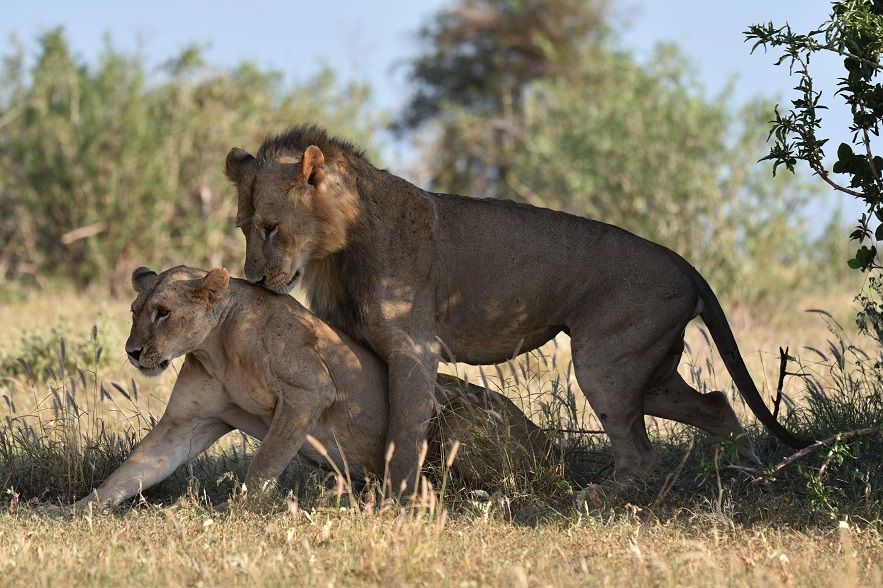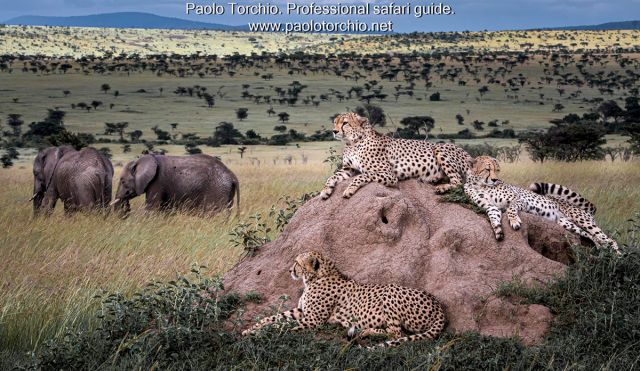
TSAVO FRIENDS
27-02-2022 by Giovanna Grampa

The savannah has a thousand faces and a thousand atmospheres and in this period it is pervaded by a new flow of energy, while stories are enriched, with the opening of the season of love. February is the month of love par excellence and even animals celebrate it by planning future births or consecrating the maternal love of newborns because love is a universal concept that concerns every being living on this earth.
After the abundant rains of last December, which created an abundance of food and water everywhere, the Tsavo is now wearing the muted hues of a new dry season: from the bright greens to the warm golden colors of the now-dried grass as the savannah is flattened and the heat begins to make itself felt with overbearance. The African spring is giving way to full summer, filling the atmosphere with traffic and secret activities.
The sightings most appreciated by tourists are certainly the couplings between lions: "Arusi" - marriage in Swahili - is the most popular word, in this period, on the radio by drivers who run from one point to another in the park to satisfy the prurient curiosity of their clients who, amused and excited, often launch into colorful comments of incitement.
For lions is not really a fun but it is the law of survival of the species that involves expenditure of considerable energy because the couple will stay together for at least three to four days, mating often, at least at the beginning, every twenty minutes.
The courtship is typically feline, with the female meowing purring and rolling on the ground with coquetry while the male begins the mating that lasts a few seconds, with loud explosive grumbles, grabbing with his teeth the nape of the lioness, with a passionate and possessive gesture. When everything is completed, the female lioness lashes out at her mate, holding back her claws, which quickly retreats and then lies down a few meters away relaxed, with her eyes closed in an ecstatic expression and her hind legs extended. After twenty or thirty minutes the lions get up again and mate again and so for a few days, nights included, without drinking, without eating getting weaker and weaker. The last couplings are exhausting for both of them and they lose strength and ardor.
In the savannah wander also young and mighty lions with tawny caramel colored manes intent on sniffing the olfactory signal of a female in heat: they curl their noses as in a grimace, with half-closed eyes, raising their lips and showing off their white and shiny teeth, waving their heads from side to side with the black brush on top of their tails which slowly oscillate. Scientifically, this behavior is called "flehmeng" and allows the male, when the female is receptive, to detect the presence of sexual pheromones, an irresistible scent that predisposes the male to respond to the invitation brought by the wind.
The males of zebra and giraffe are also engaged in reproductive activity: they sniff the females, follow them assiduously with tender attitudes to finalize the mating after having fought with bites and kicks for dominance.
Groups of giraffes move elegantly in the clearings with a slow and sinuous gait: among them young specimens of a tender beige, on their long legs almost swaying in a dance made up of playful pirouettes, typical of children's games, while the females in heat are literally tailed by the males who sniff them insistently and follow them by rubbing or leaning their heads on their hind sides. A courtship that lasts for a long time before the female, with her tail rolled up on her rump, shyly, almost reticently, grants her favors.
More and more herds of zebras graze in the open spaces rich in grass. Among them, foals with legs that are too long for their downy bodies and with ill-defined, chocolate-colored stripes, stand close to their mothers, looking around with astonished and curious eyes, while the stallions, with their powerful quarters, proudly raise their necks, challenging each other or sniffing some female in oestrus.
It is a time of passionate love also for the crowned cranes, birds of a singular elegance with the characteristic crest on the head, formed by erect feathers of a beautiful golden color that stands out on the black and white plumage of the head, in contrast with the bright red wattles and the gray-blue iris of the eye.
The courtship begins with a very animated and always spectacular dance: they hop with their wings outstretched, they bend on their legs with elegant poses, they emit strong calls with sequences of harmonious bows, jumps, runs, short flights, the prelude to mating. Crowned cranes generally lay 3/4 eggs and the hatching lasts an average of thirty days: both parents are dedicated to it. It is a pleasure to observe them and the show is assured.
There is an intoxicating sense of excitement in the savannah: everyone is preparing to have young and raise them in that brief and fickle period of abundance. Everywhere there is a sense of new life, of rebirth after the long ordeals of the past dry season, which lasted too long.
There are those who, on the other hand, celebrated Valentine's Day in the savannah a few years or a few months ago, judging by the presence of numerous puppies that mothers of all species look after with tender love, nursing them with dedication.
It often happens to see appear out of nowhere a line of silent elephants led by a matriarch, followed by females of various ages, and between their legs an unspecified number of young, even born just over a month, well protected not only by their mothers but by all the adults of the herd. They were conceived at least two years ago, during the period of Covid-19 containment restrictions, when access to the parks was denied. Now the mothers watch beaming as the babies evolve around the legs and under the bellies of the adult females as they play, preparing them for their adult lives.
Around them, swarms of bee-eaters flutter in search of insects raised in the dry grass by the elephant herd, while not far away, a large male bustard, with white swollen feathers on its neck, walks through the grass with its round eyes and emits a sound repeated at regular intervals like drum beats: it is its wedding song.
It is also the period of maternity for gazelles, impalas, warthogs, Egyptian geese, buffaloes in the undulating bushy savannah and in the Galana river hippopotamus babies remain well glued to their mothers so as not to be dragged by the current. Every living thing from grasshopper to giraffe, jackal to oryx, gives birth to its young before the dry season starts again.
Even the friendly warthogs roam the savannah with a large number of cubs that usually cannot resist the charm of the water in the ponds. With a bright orange coat and a shaggy mane sloping down on the back, while the adults drink, the little ones roll around playfully in the mud, transforming themselves into delicious little chocolate-colored bundles from which sprouts a stiff little tail as straight as an antenna.
And it is not uncommon to see, in the shade of a generous thorny acacia tree, many young impalas, with a silky, light beige, almost honey-colored coat, all sitting together to rest, like children in kindergarten, cared for by young females attentive to the possible attacks of some hungry predator.
The flow of energy also explodes during the night and the animals are in continuous movement, just like all of the nature that surrounds us: elephants that meet and greet each other with the touch of their tusks and the intertwining of their trunks, jackals that yelp with a trembling voice and from afar comes the roar of a lion, serious and insistent: the African night is full of mystery.
Regardless of the evolution and strategy adopted, cubs are the greatest investment in the existence of a living being; their survival allows the duration of a species, generation after generation, reminding us how precious it is to defend our Planet from this irrepressible and exciting beauty.
In Africa, what is left to tomorrow is lost forever!
WILDLIFE
by redazione

The figures presented by ICEA, Lion General Insurance Company at the Kenya Wildlife Service are clear, this year has reached the 100 mark lions killed in the bush of Kenya.
WILDLIFE
by redazione

NEWS
by Adriano Ghirardello, Honorary Warden KWS

The "boom" of unmanned drones with which to film scenes from the top and up close, is likely to create problems to the animals in the savanna and to those who use them, given that Kenya is illegal. To use...
TOURISM
by Leni Frau

Seventy million images examined on the largest photography portal, Flickr, cannot lie: Kenya...
FRIENDS OF TSAVO
by Giovanna Grampa

Fans of TV series of Channel 5 will know as an interpreter of the Carabinieri, Centovetrine, The three roses of Eve, just to name a few. He is Roberto Farnesi, film and television actor, well known to the public, especially...
SHOWS
by Leni Frau

Second full Thursday for Freddie and Sbringo's show focused on stories of men and ...
SAVANNAH
by redazione

For those who spend their holidays in Malindi and surroundings, the safari magic is at hand.
The entrance to the Tsavo National Park is only 100 kilometers and takes two days just for something unforgettable.
But few know that just...

AMICI DELLO TSAVO
by Giovanna Grampa

Unfortunately this time we could not save one of the many wonderful animals that inhabit the savannah around Malindi.
After saving elephants fell into puddles and lions freed from the bonds placed as traps by poachers, the animal world has launched...
FRIENDS OF TSAVO
by Giovanna Grampa

Italians friends of animals to save a lion of Tsavo doors.
An extraordinary adventure happened last Sunday in the border of the Galana Ranch Conservancy with the Tsavo East National Park.
A bloody trap, placed by poachers in order to...

Second weekly evening of the show in episodes on the "BIG 5", this evening Thursday, August...